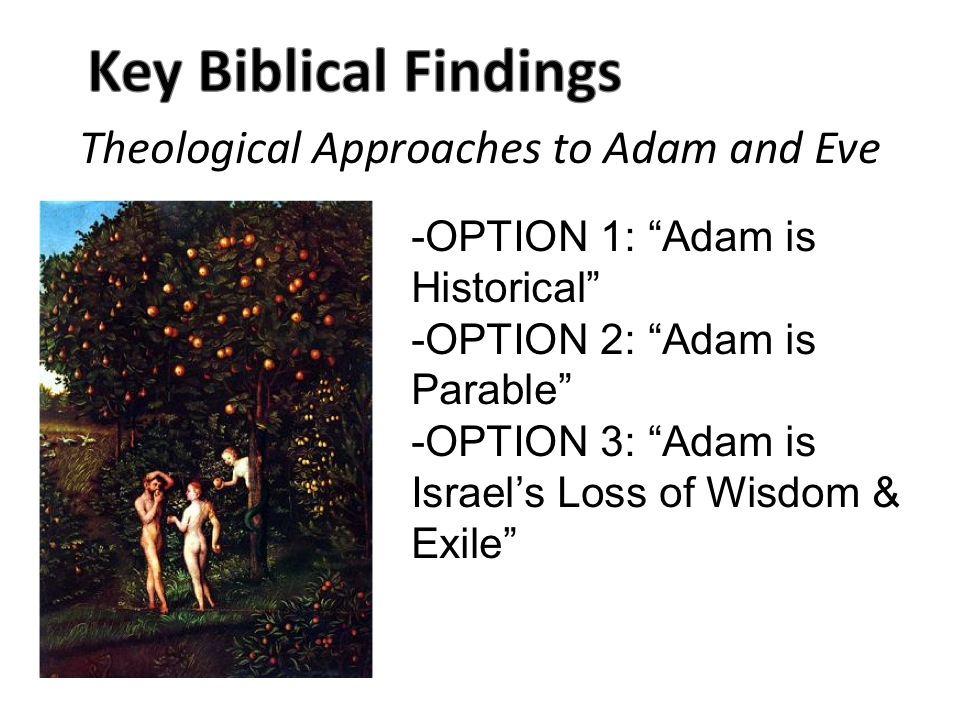The following series is based on my senior paper for Seminary. You may remember a video where I invited people to contribute their stories to help make my case. For the next couple weeks, I’ve decided to share my findings with you all. There will be a “thesis/problem” section, a “biblical theology” section, and an “application” section. I hope you will read along and share this with others! You can read the rest of the series here.
—————————————————————————————
Option 3: Adam is Israel’s Loss of Wisdom and Exile
Peter Enns puts forward a third option for understanding Adam and Eve. Although I see all three perspectives as viable, I gravitate toward Enns’ approach. The following idea is essential: “The early chapters of Genesis are not a literal or scientific description of historical events but a theological statement in an ancient idiom, a statement about Israel’s God and Israel’s place in the world as God’s people.”[1]
As discussed earlier, Genesis 2-3 comes from the “J” source, which is older than Genesis 1. In ancient Israel, possibly around the time of Solomon,[2] the theme of the Adam story was parabolic of Israel’s loss of wisdom. Adam is depicted in such a way as to be the “proto-Israelite.” In other words, Adam is Israel.[3] In its earliest forms, the story of Adam and Eve was “not really a story of the beginning of humanity but of one segment of humanity…” (66). The story is not lacking in universal overtones, but is primarily a self-defining document of origins for a singular people – Israel (Ibid.). The story might have circulated orally in various forms prior to its final form and “was probably rethought and retold along the way as Israel grew and developed in its self-understanding” (141).
Early on, Adam’s narrative functioned within the genre of Israel’s Wisdom literature. For instance, “When read in light of Proverbs, the Adam story is about failing to follow the path of wisdom and reach maturity and not about a fall from perfection” (142). Interestingly, the Hebrew Scriptures never speak of Adam as a universal source of sin and death; they hardly ever refer to him. For the Old Testament writers, Adam is a marginal character (82-84).
Adam is depicted as similar to the son whom the Proverbs attempt to train in wisdom. God desires for Adam and Eve to gain wisdom, but this must be done at a pace consistent with God’s path for them. The problem is not that they sought wisdom, but that they did so via their own methods rather than following God’s way forward. Just like Adam took the fruit from the tree, so also in Proverbs, wisdom is referenced as being “a tree of life to those who take hold of her” (Proverbs 3.18). Abundant life comes from wisdom and so the tree of life maintains this status. Enns further explains:
Life can only be gained through wisdom, and wisdom is rooted in the fear of God – which in the garden story means obeying God’s command. When Adam and Eve depart from the true path, they lose life – they are barred from eating of the tree of life, to which they had been given free access previously (90).
Much more could be said about the connections to wisdom, but ultimately it suffices to note that the Adam and Eve story serves as a narrative account of the broad themes in the book of Proverbs. Ultimately, the striving for wisdom down a path of folly led to Israel’s suffering as a people, the very thing the Adam story both warns against and retells (90-91).
By the time the text came into its final form, during and after the exile, the Adam is Israel theme was fully focused. The editors of the Pentateuch (the priestly redactors) placed the specific story of Israel’s origins on the back of the cosmic origins story in Genesis 1. Genesis 2-3 does not reflect literal history, but a narrative that “mirrors Israel’s story from exodus to exile” (66). The logic follows this pattern: a) Israel is “created” as a nation in the exodus after a period of instability, and Adam is created in Genesis 2 after the chaos of Genesis 1 is put into order; b) Israel inherits a lush land to dwell in, Adam is placed in a lush garden; c) Law is given to Israel as a condition for remaining in the land, and “Law” (the tree of knowledge) is placed in the garden and Adam’s obedience is required in order to stay; and d) Israel continues in a pattern of rebellion leading to their exile into Babylon, and Adam and Eve are exiled from the garden because of their rebellion.[4]
Finally, we must examine the Apostle Paul’s approach to Adam. Peter Enns brings two issues to light. First, Paul appropriated the story of Adam and Eve to reflect his understanding of the resurrection of Jesus. New Testament writers often gave fresh readings to their Scriptures as they attempted to explain the significance of the saving work of Jesus. Paul used the Adam story “to highlight the work of Christ and the equality of Jew and gentile” (142). This idiom provided a clear means of communicating the “problem of sin and death and the solution that God provides in Christ” (143).
Secondly, Paul used this interpretive grid in a culture that already had several interpretive perspectives on the Adam story, specifically within the conventions of Second Temple Judaism. He does not do a plain exegetical study of Genesis 2-3, but under the influence of the Holy Spirit, uses it to point to the supremacy of Christ, for both Jew and Gentile. Paul’s ultimate point is that the problem of sin and death has been dealt with through the cross, and all humanity is “equally subject to the same universal dilemma, sin and death, and so both require the same Savior” (81). To summarize:
Jews and gentiles share the same plight, and Jesus came to solve it. And all of this stems from Paul’s rereading of his Scripture in light of the central and prior conviction that God raised Jesus from the dead… Explaining Paul’s Adam this way… shows… a high view of Christ – so high that even Israel’s story, specifically Adam, must be recast to account for Christ. Paul invests Adam with capital he does not have either in the Genesis story, the Old Testament as a whole, or the interpretations of his contemporary Jews. His reading of the Old Testament in general is creative, driven by hermeneutical conventions of the time and – most importantly – by his experience of the risen Christ. Hence, Christians who take Paul’s theology with utmost seriousness are not also bound to accept Paul’s view of Adam historically (135).
[1]. Enns, The Evolution of Adam: What the Bible Does and Doesn’t Say about Human Origins, 56.
[2]. Brueggemann, Genesis, 14.
[3]. Enns, The Evolution of Adam: What the Bible Does and Doesn’t Say about Human Origins, 88-89. Note: the following citations from this resource will be done within the text.
[4]. Ibid., 66-70. See Also: Peter Enns, “Adam is Israel,” BioLogos Foundation, http://biologos.org/blog/adam-is-israel/ (accessed February 20, 2012).












